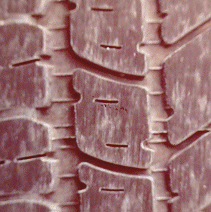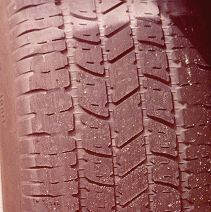
The Traffic Accident Reconstruction Origin -Approach Angles Solution-


The Traffic Accident Reconstruction Origin -Approach Angles Solution-
|

|
This hypothetical collision involves a 1983 Chevrolet Caprice. The collision vehicle has struck a child on a residential street. The child is seriously injured. The major question that has emerged is how fast was the car going.
As the investigating officer you can see four skid marks in the roadway. You are convinced
that the skids you are looking at came from the Caprice in question. The following facts lead you
to that conclusion:
|
|

|
|

|
|
In an attempt to document the length of these skid marks you back away from the car and look down its path. Backing away you can see the marks change from their dark character to a lighter mark, then disappear. You conclude that the skid marks begin as shadows, but it is difficult to tell just exactly where they begin.
You ask your assistant to stand near the end of the shadows and you continue to walk back away from the car. Twenty or thirty feet farther you stop turn around and kneel down to the ground. From this distant, low viewpoint the obvious tire marks are even more easy to see. But, more importantly, it is now easy for you to see all four skids and where the shadow marks begin. You direct your assistant to place his foot beside the beginning of all the marks. Of course it is not as easy for him to see where they begin, so you have to direct him. Once he has his foot in the right place you tell him OK, and he marks the spot.
Now it is easy for you to measure all four of the skids. Here are the lengths you measure:
| Left Front = 43 feet | Right Front = 47 feet |
| Left Rear = 50 feet | Right Rear = 54 feet |
Now you must find a drag factor. The serious nature of the injuries is enough to convince your supervisor that estimating a drag factor from a table is not good enough. You want an accurate drag factor for this road on this day.
You run your skid tests as follows:
You disable the ABS system of your patrol car by pulling the fuse from the fuse panel. You are happy that your speedometer has been recently calibrated because you know that drag factor calculated form skid tests requires an accurately known speed. You accelerate up to 45 MPH. You take your foot off the accelerator and poise both feet over the brake pedal. You make one last check through the windshield to be sure the car is pointed in a direction you want it to go. When you see the speedometer reach 40 MPH you slam on the brakes with both feet. Your patrol car skids to a halt in a cloud of smoke.
In a manner similar to the one you used to find the shadow and skid length of your suspects vehicle you mark and measure the lengths of each of the patrol cars skid marks here are the recorded lengths:
| Left Front = 56 feet | Right Front = 58 feet |
| Left Rear = 53 feet | Right Rear = 56 feet |
So as to provide confidence in your first test result you run a second test. This second test, also run at 40 MPH yields the following results:
| Left Front = 53 feet | Right Front = 58 feet |
| Left Rear = 56 feet | Right Rear = 57 feet |
Was the suspect in excess of the 30 MPH speed limit when he locked the brakes?
|
Copyright ©
|